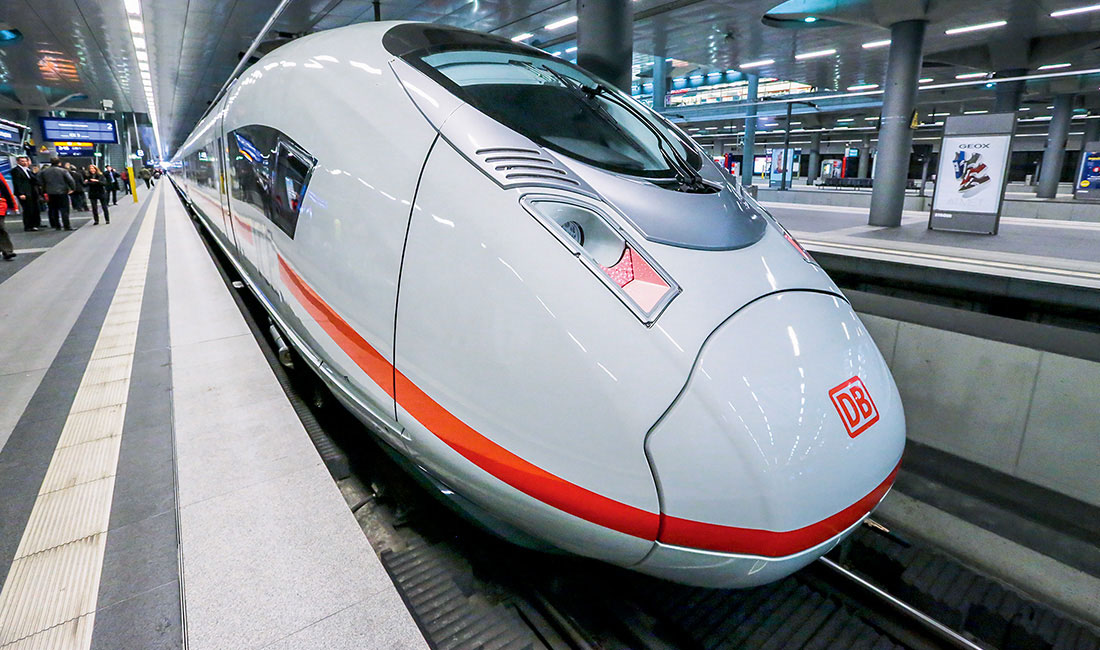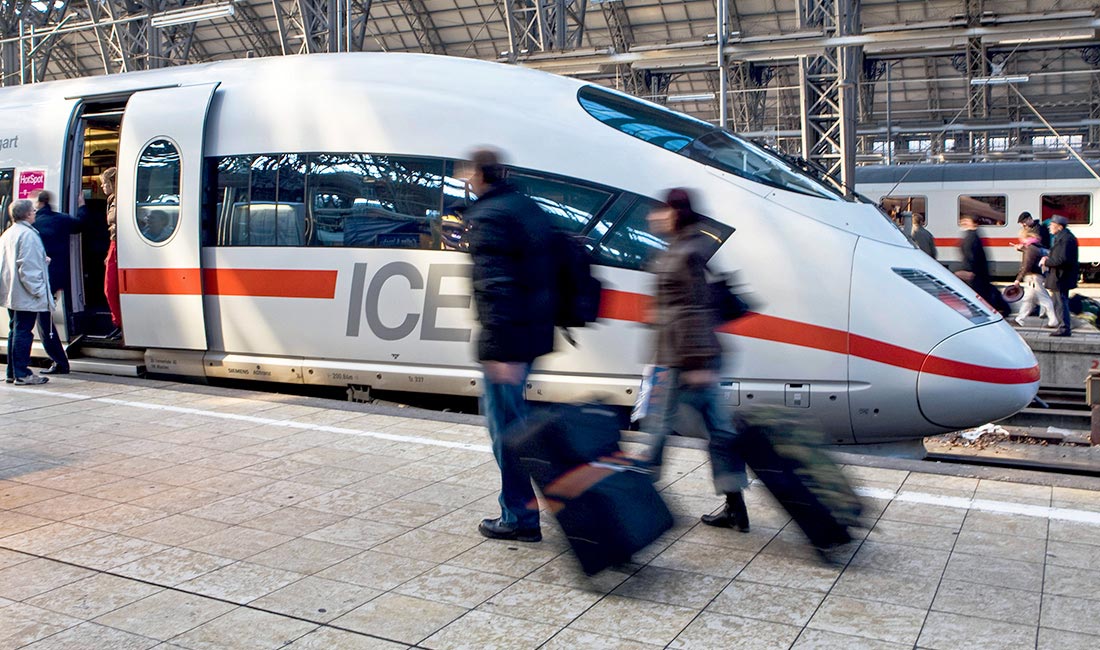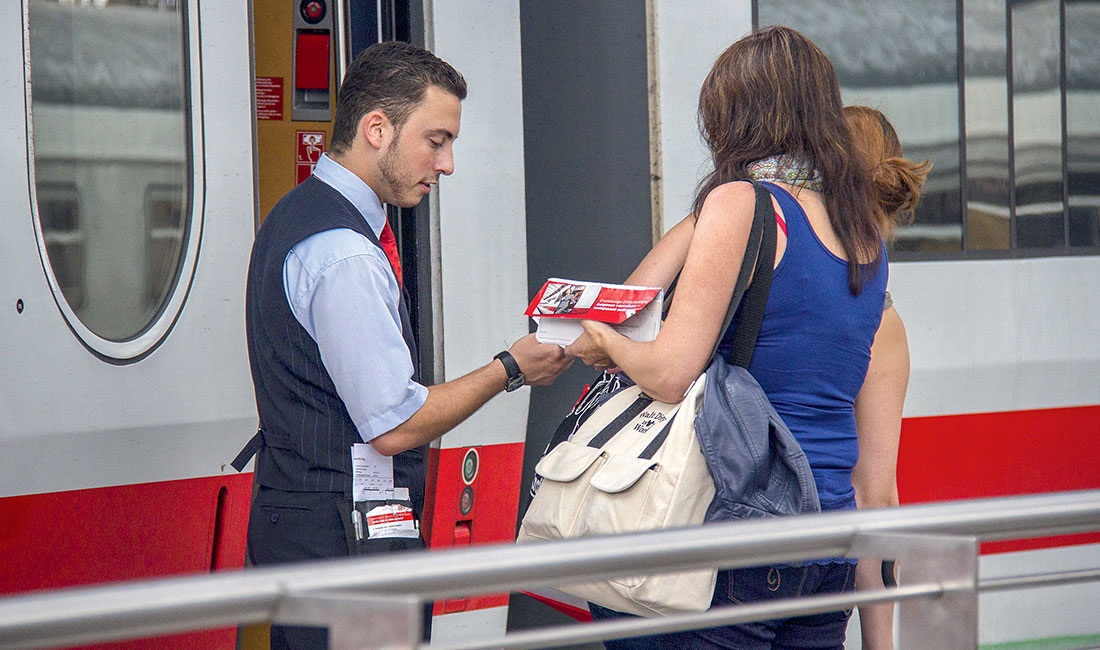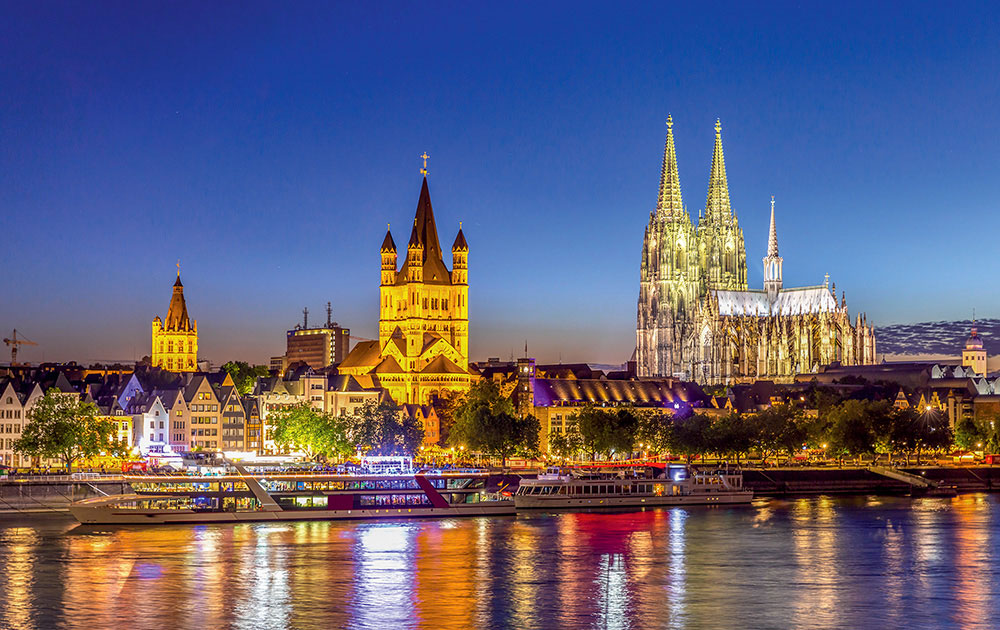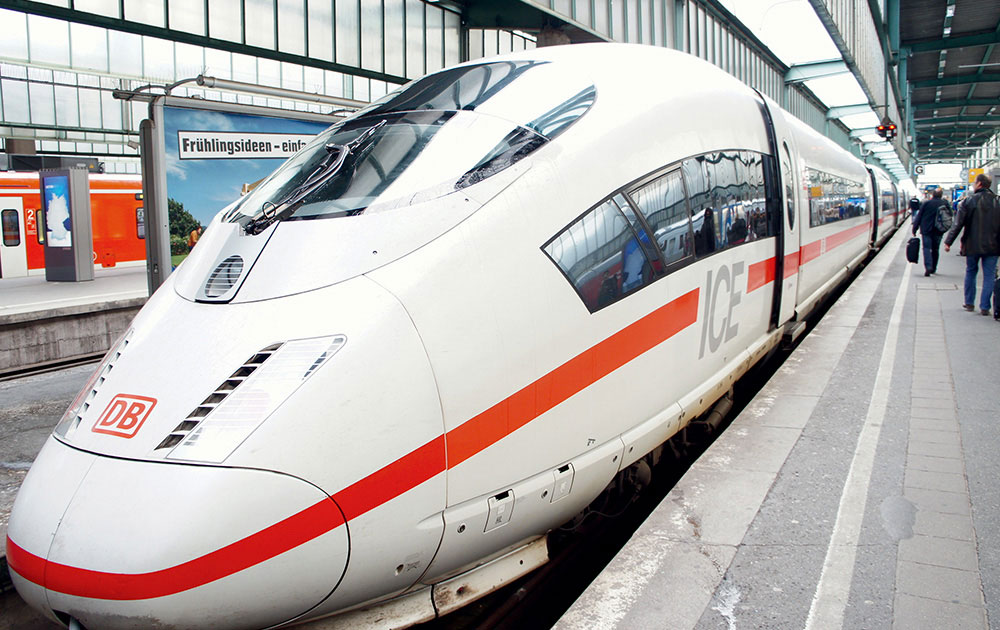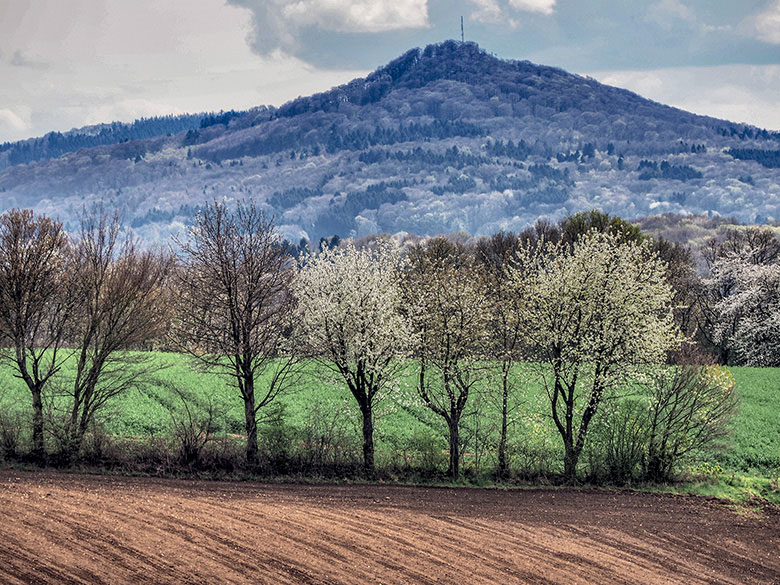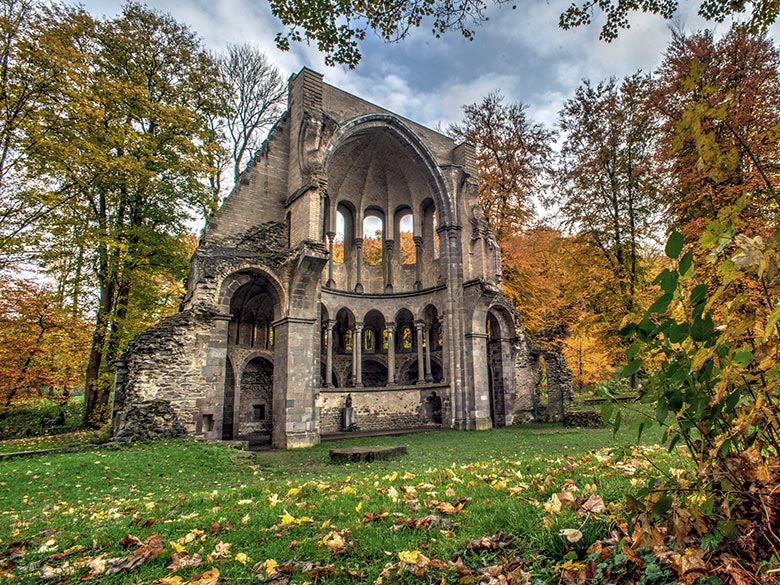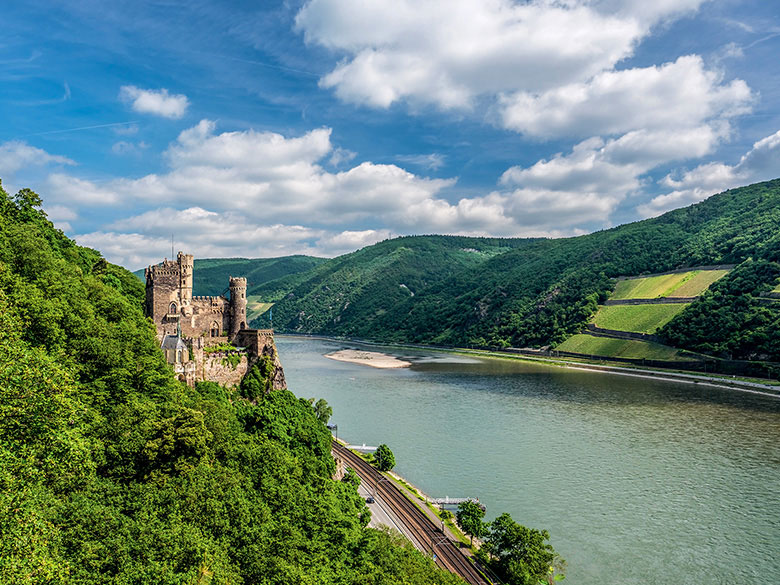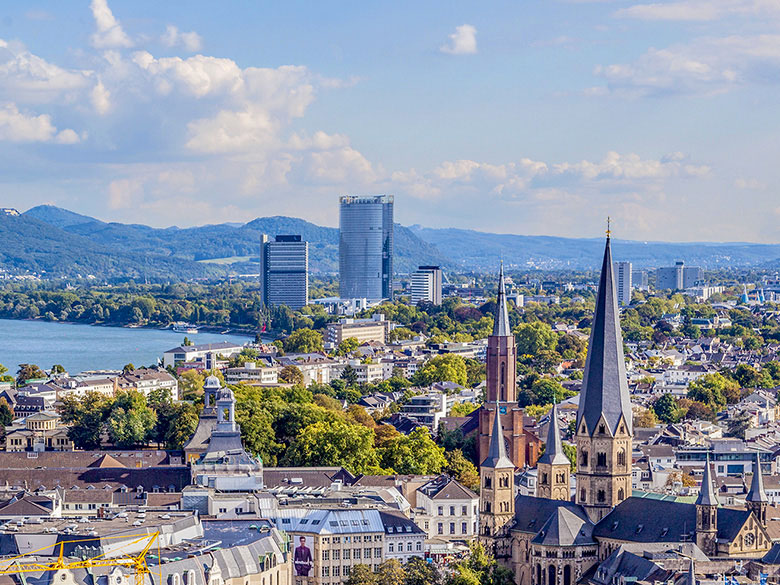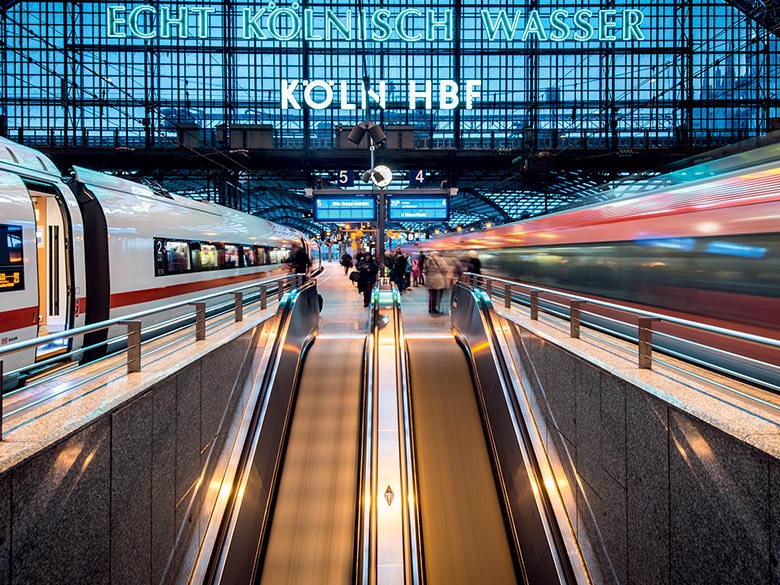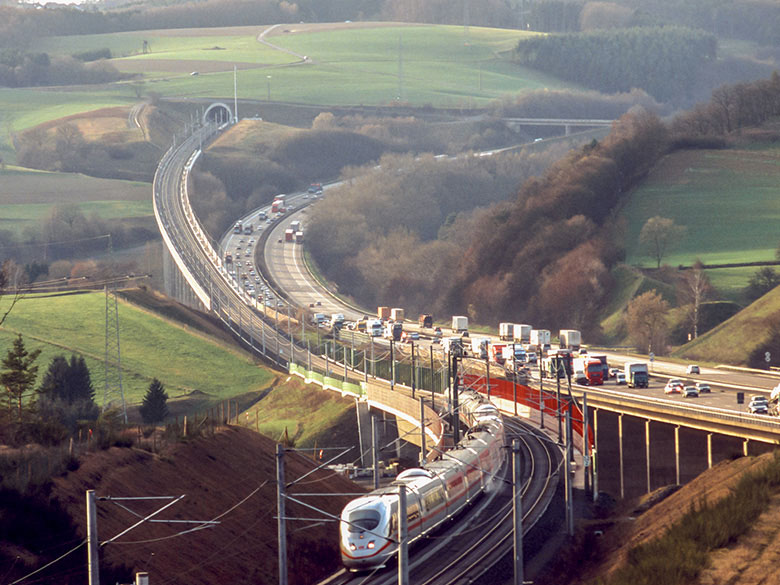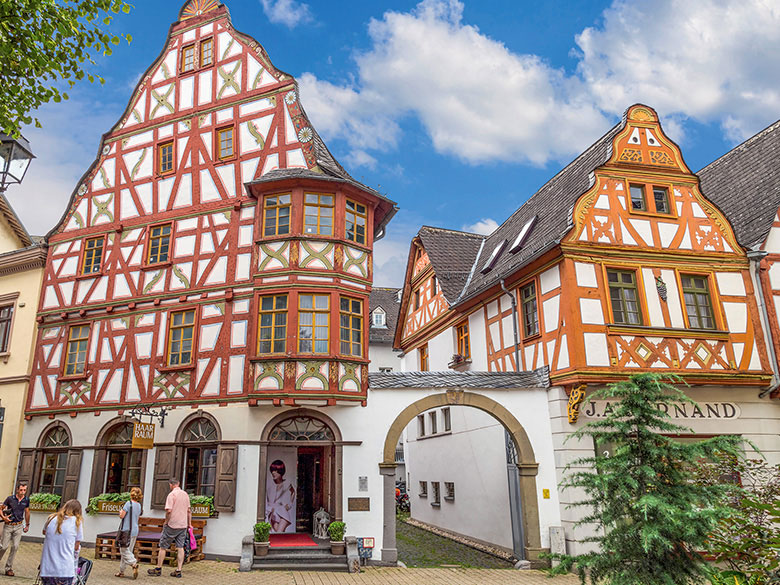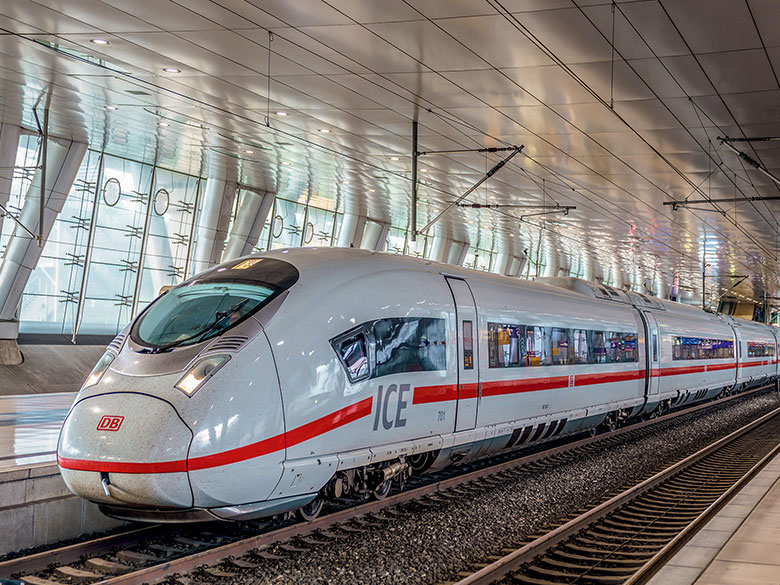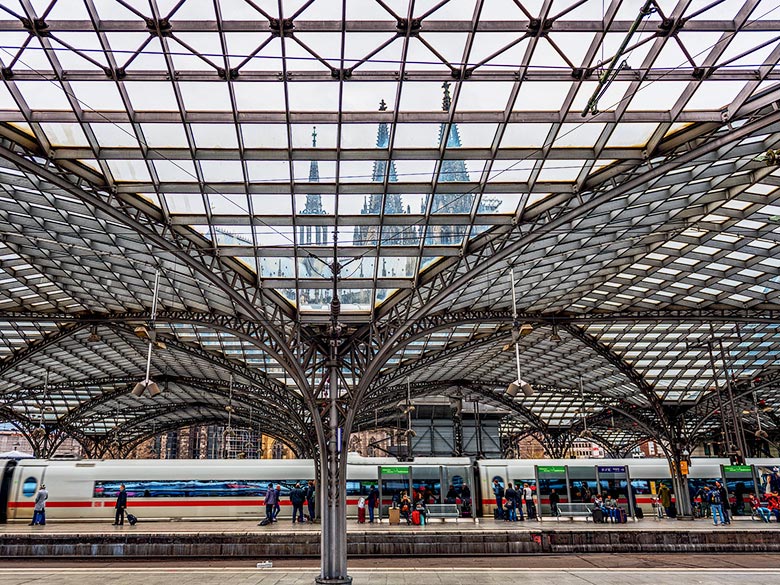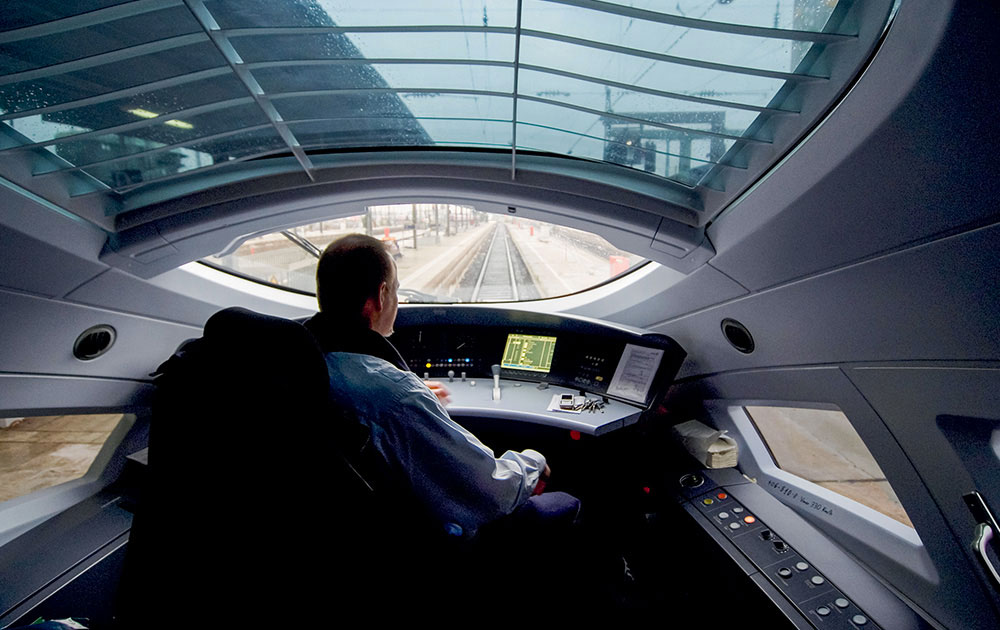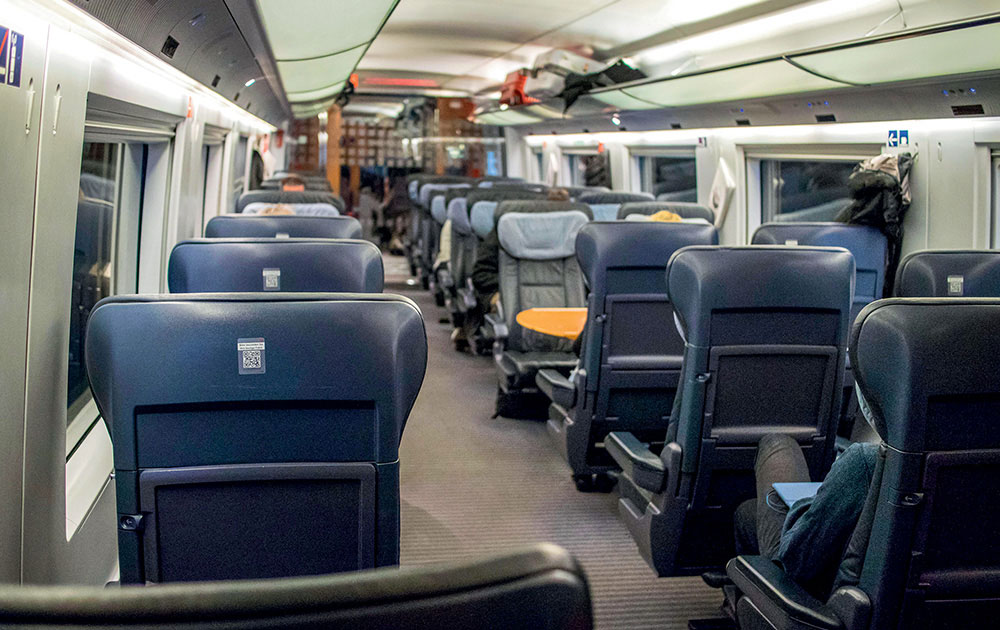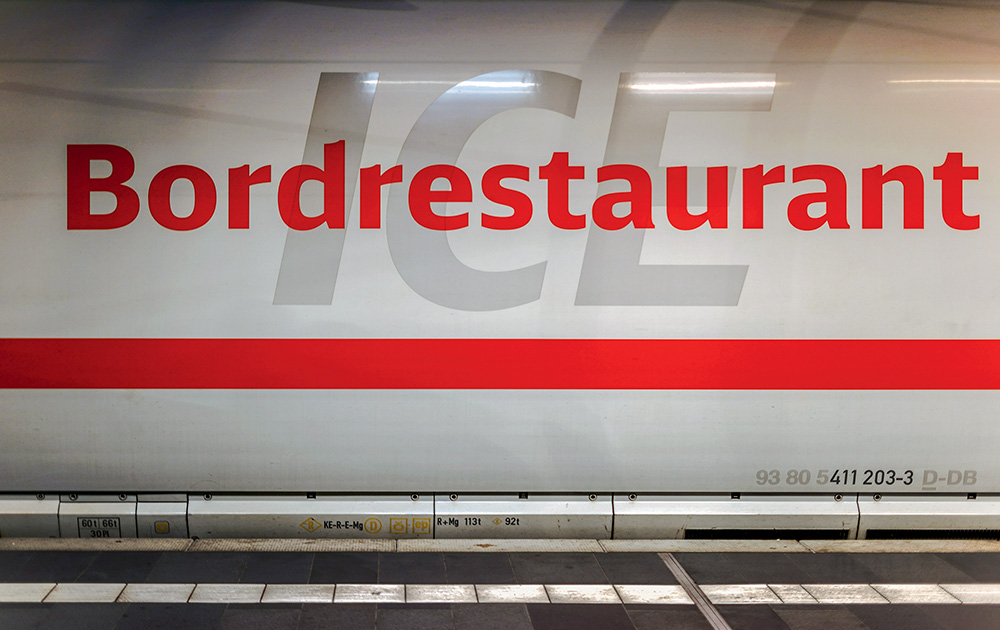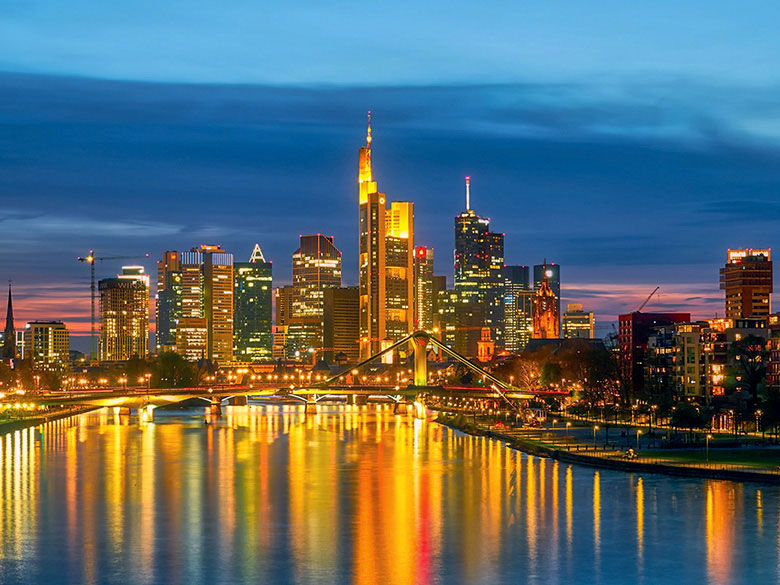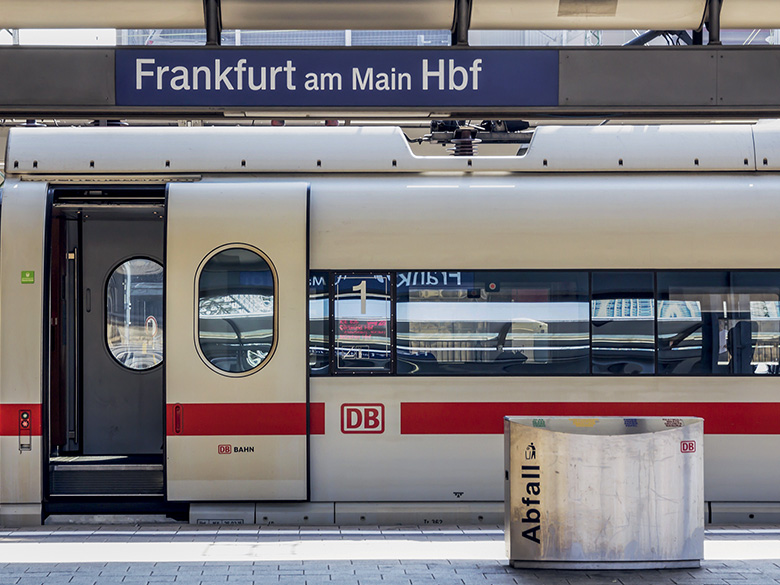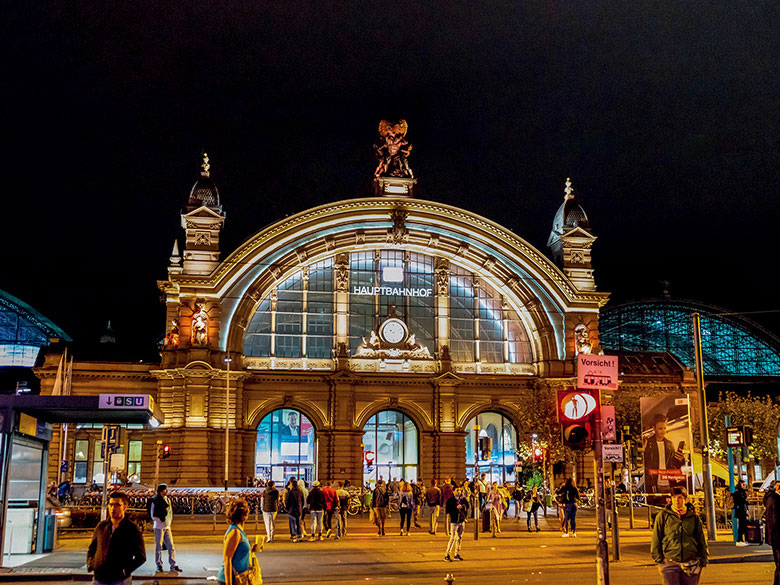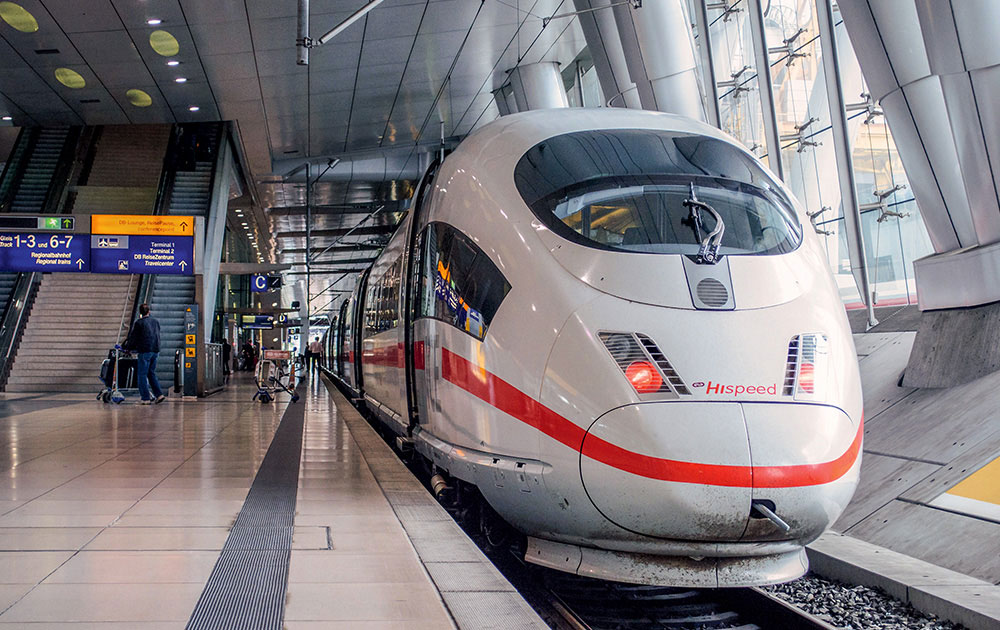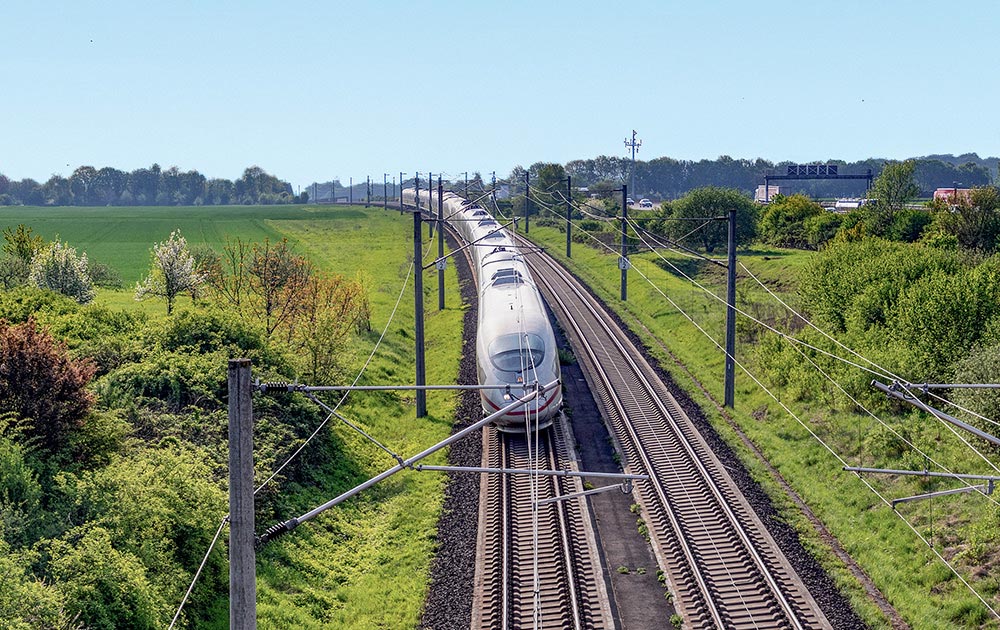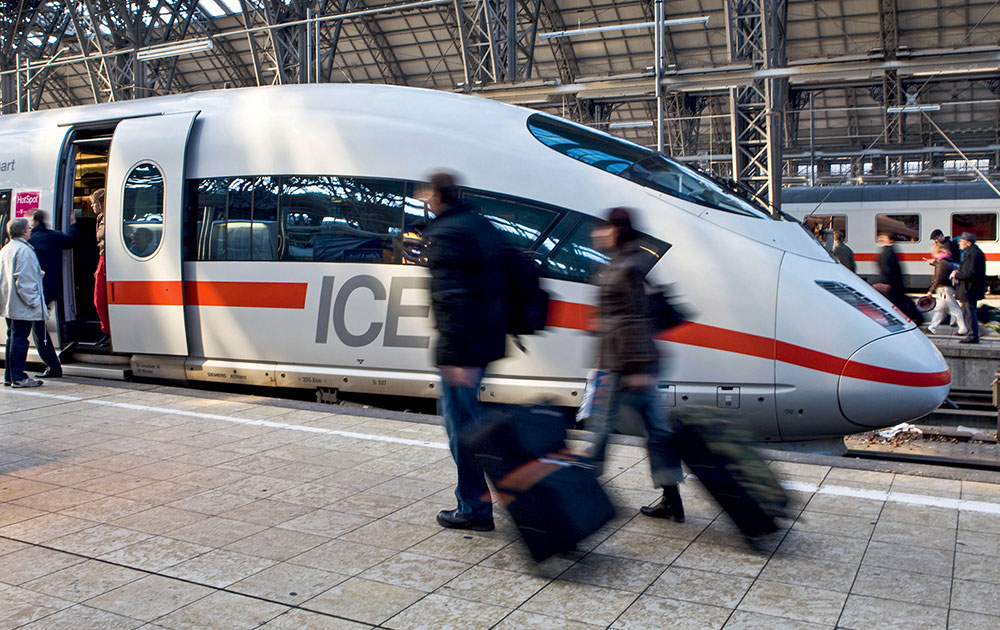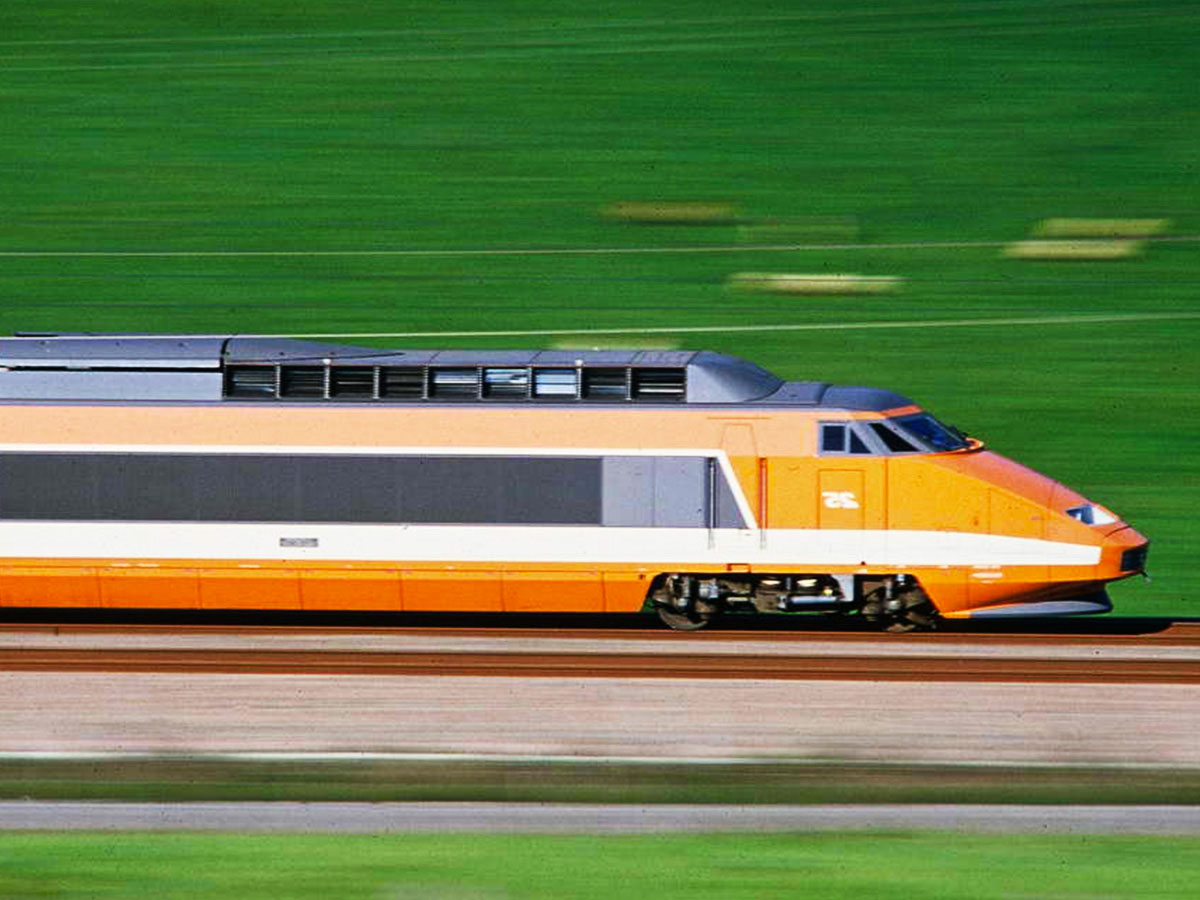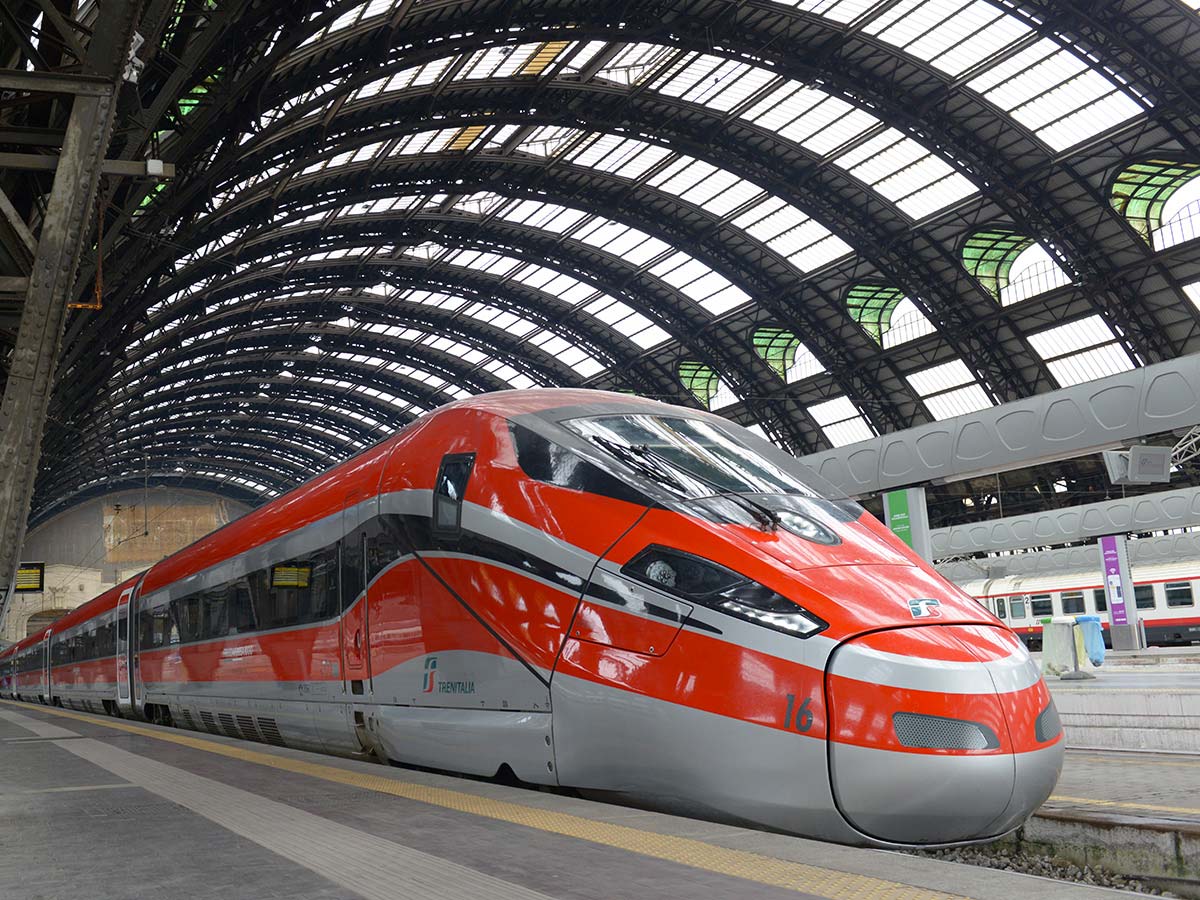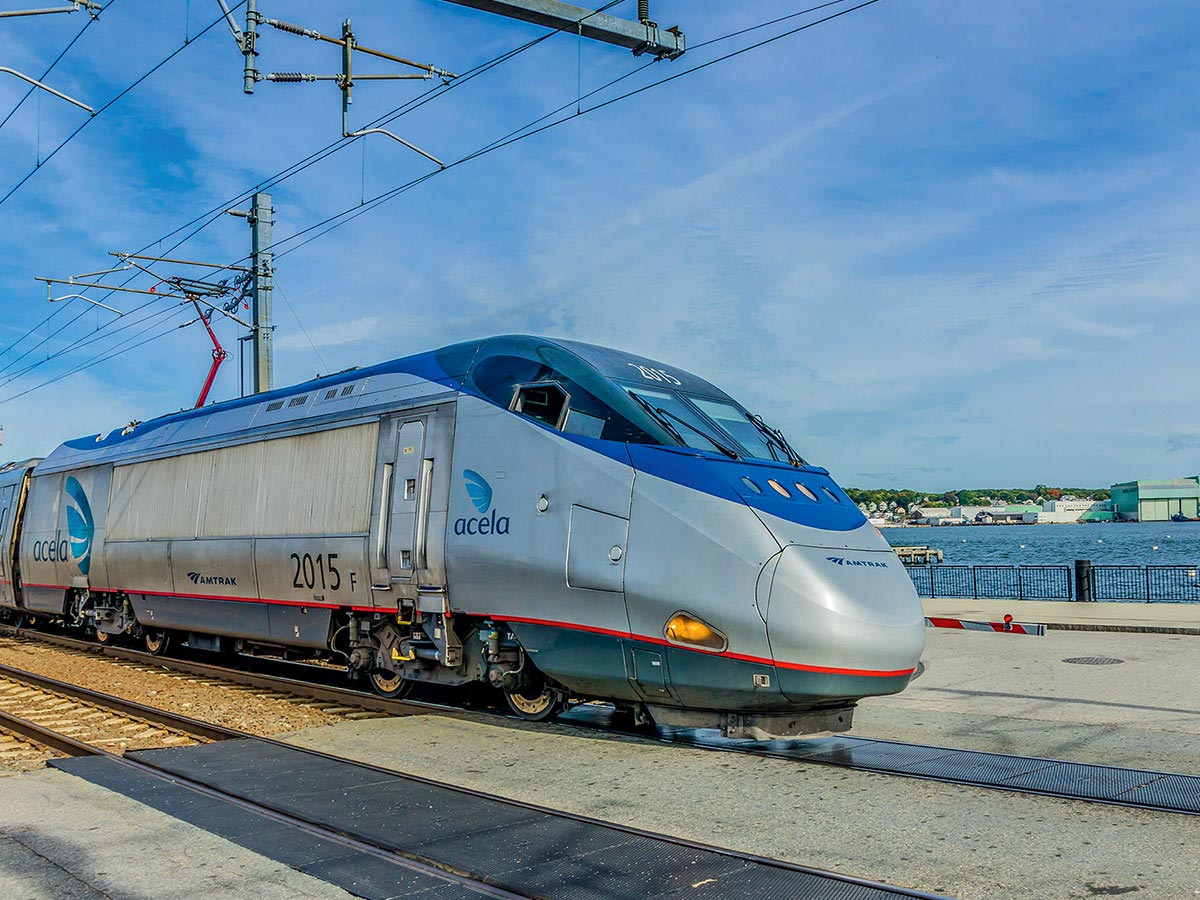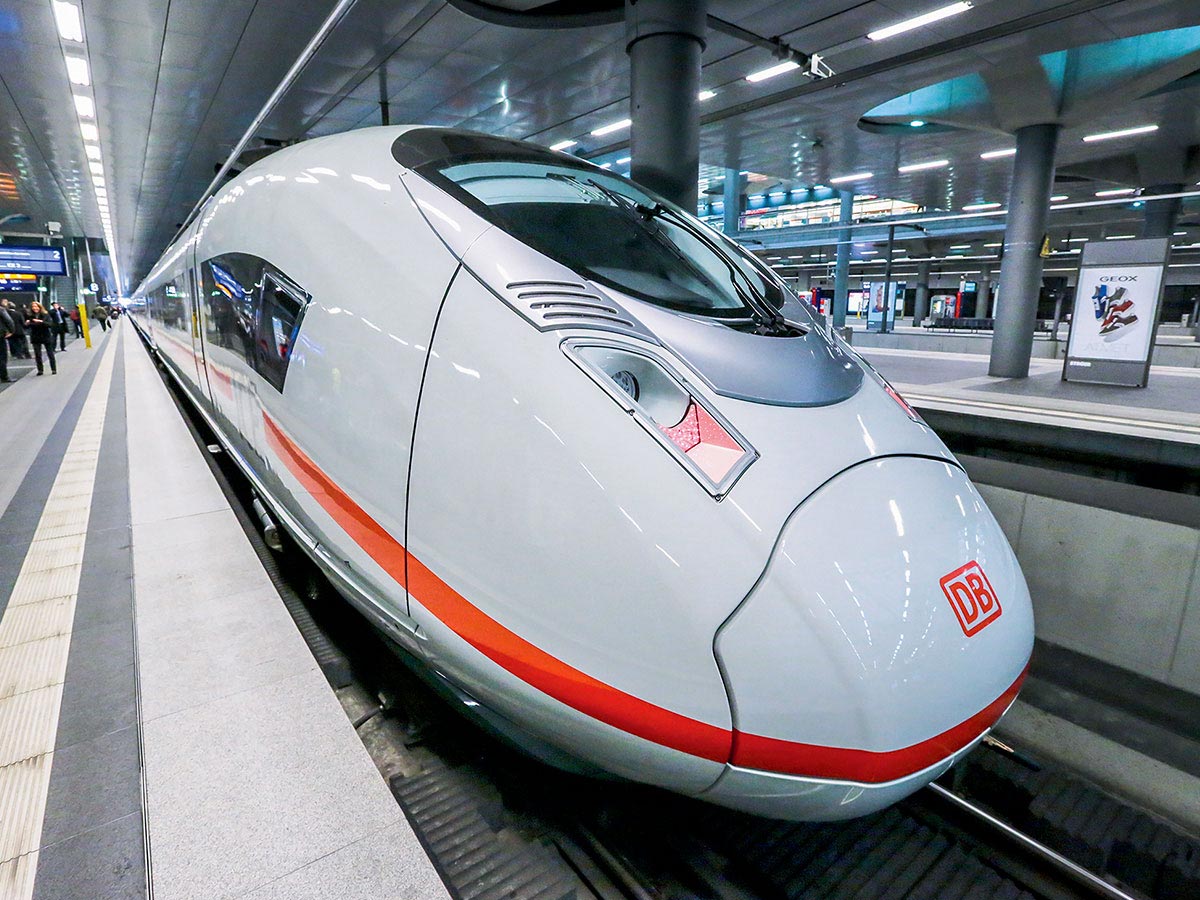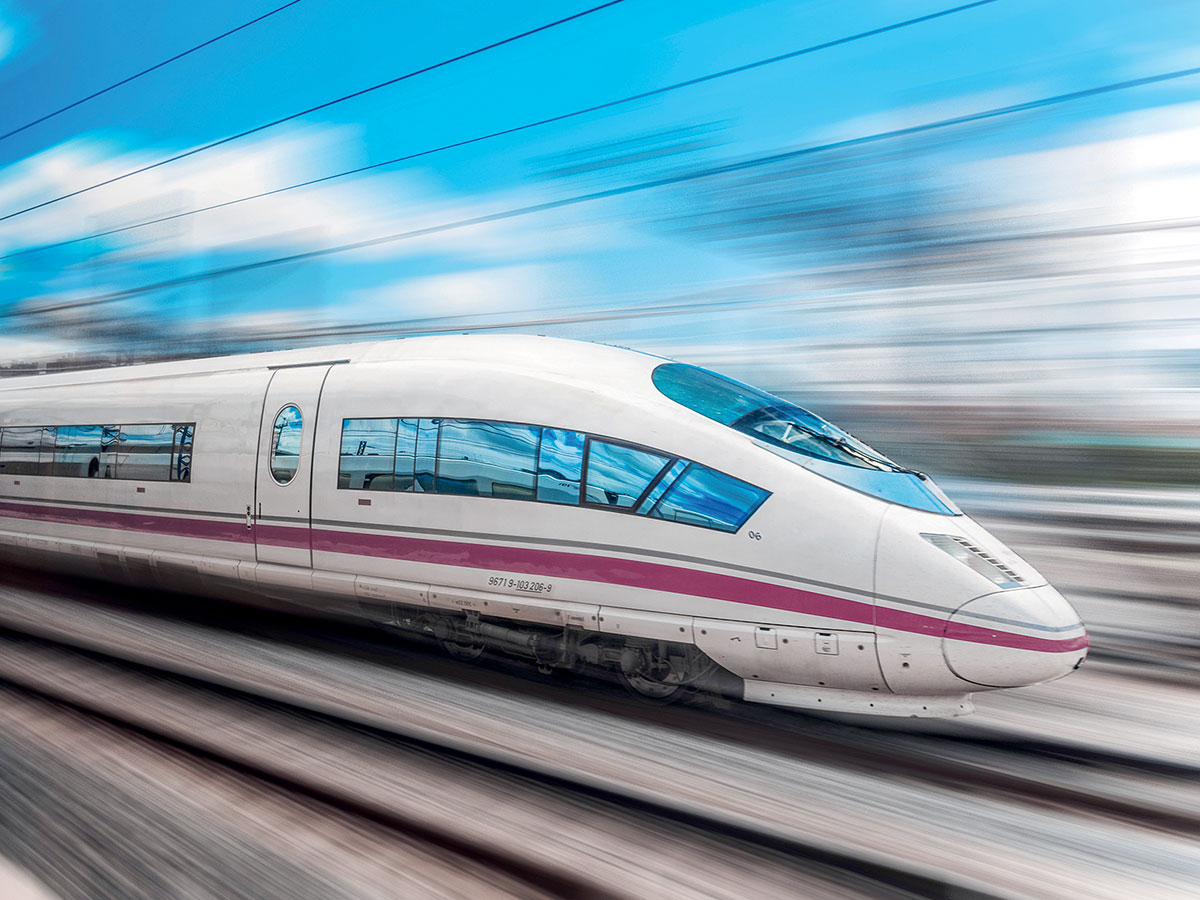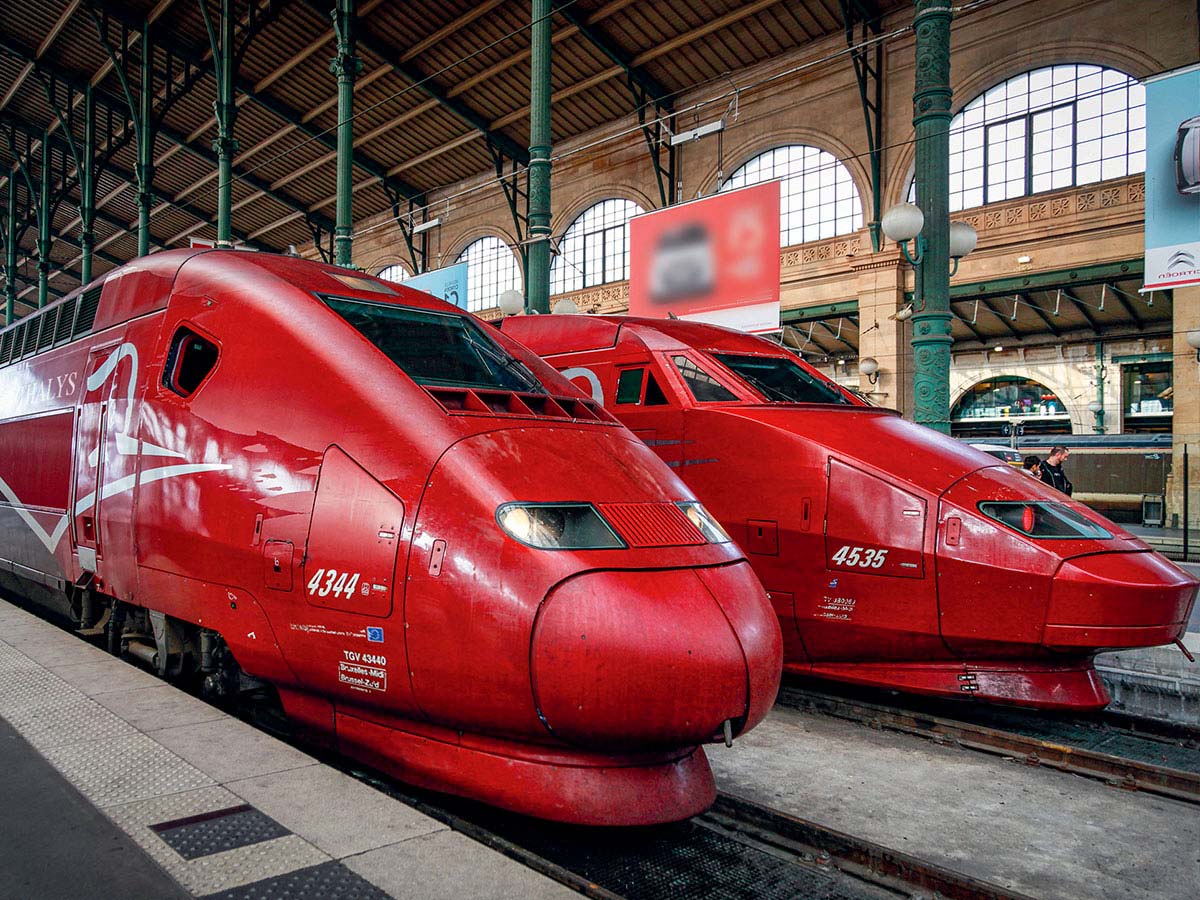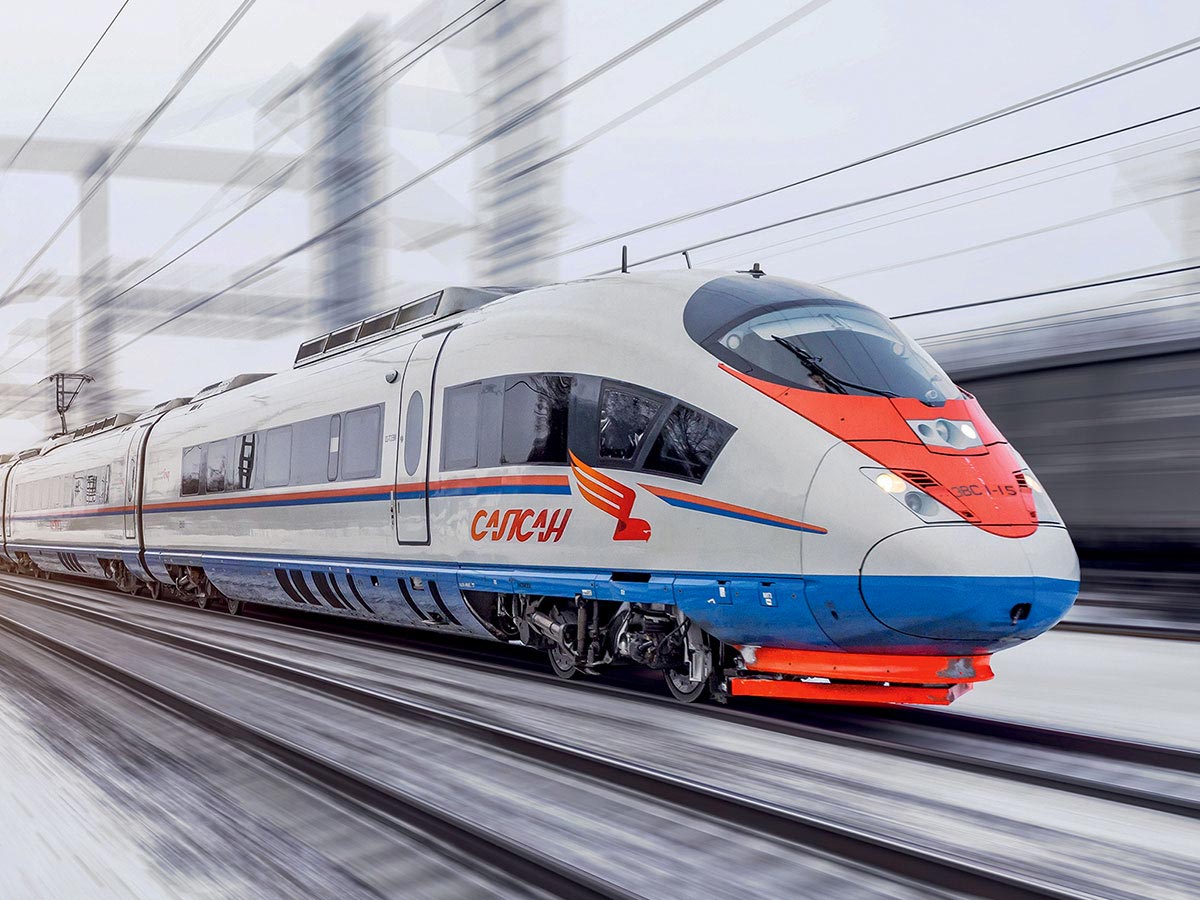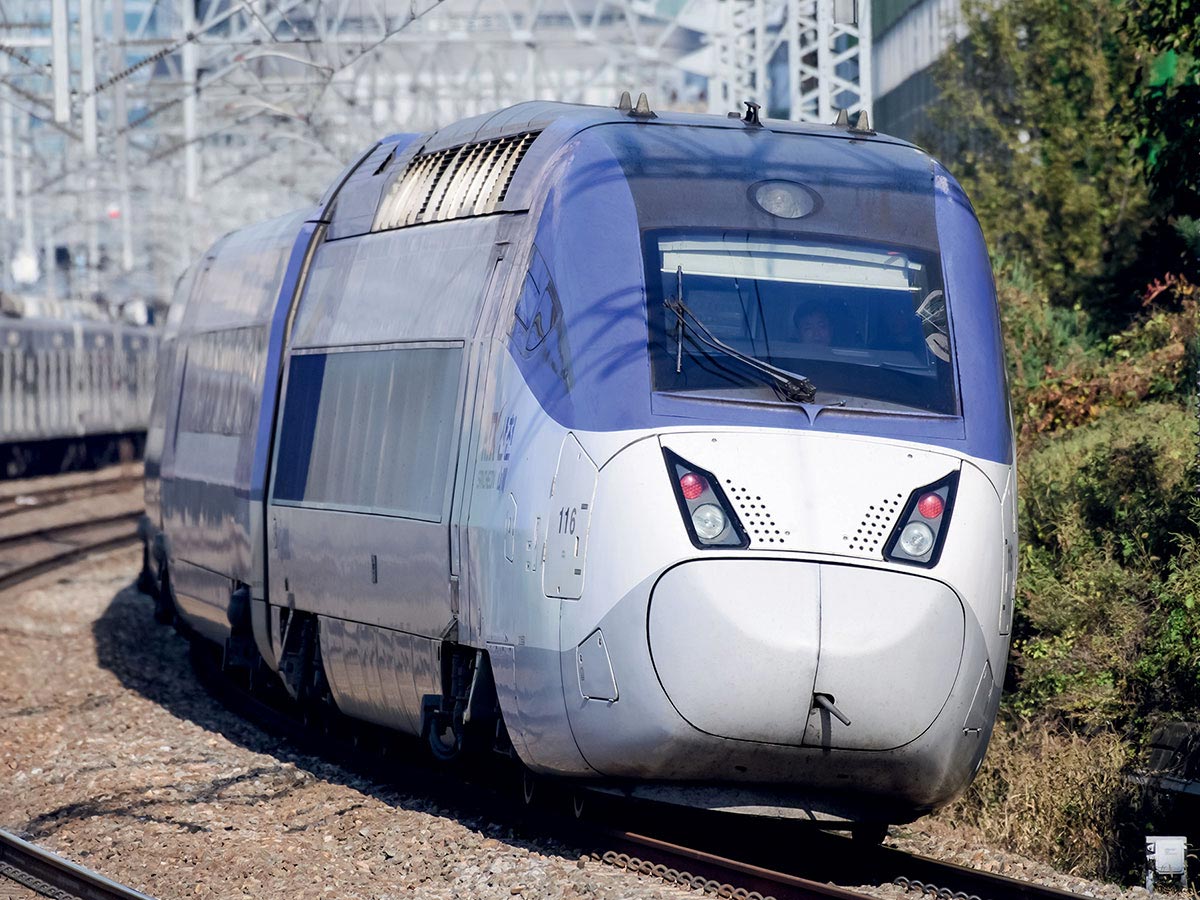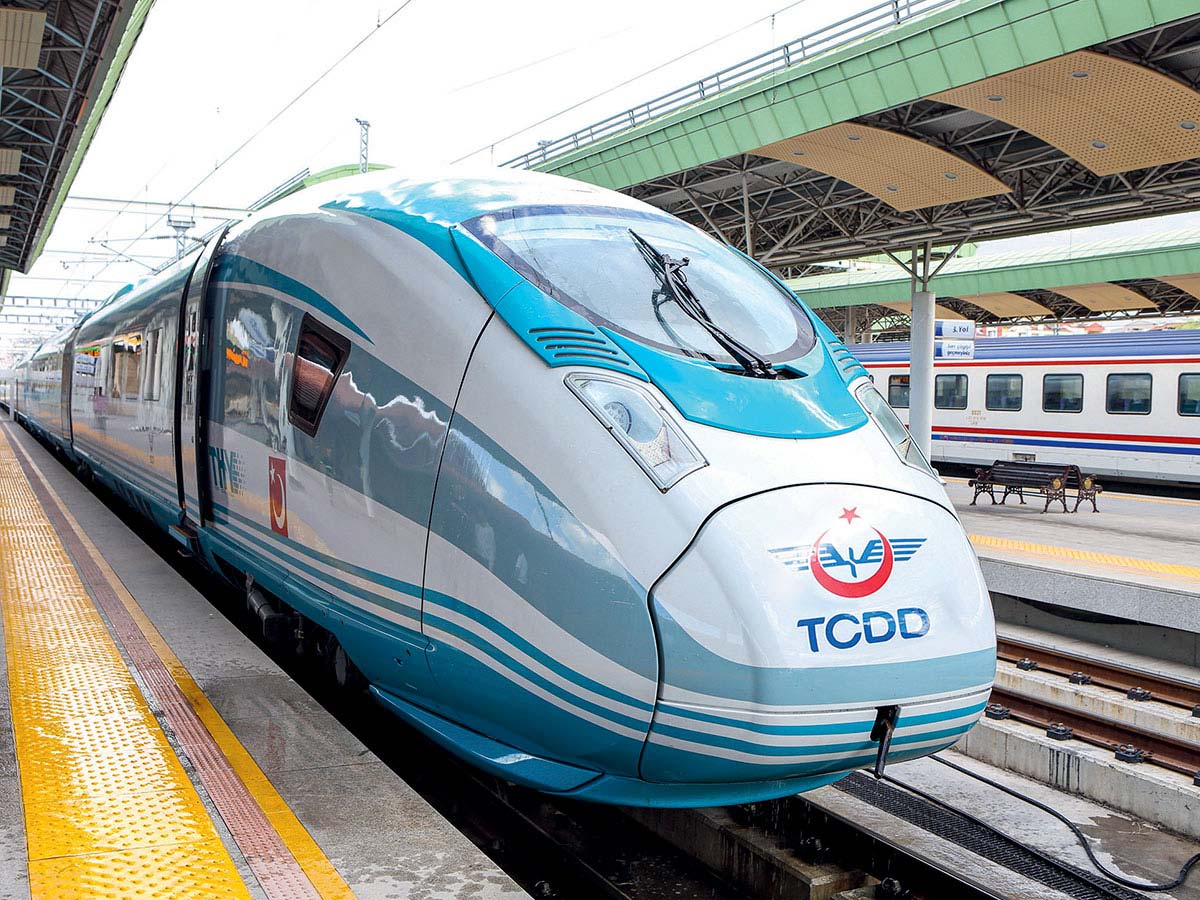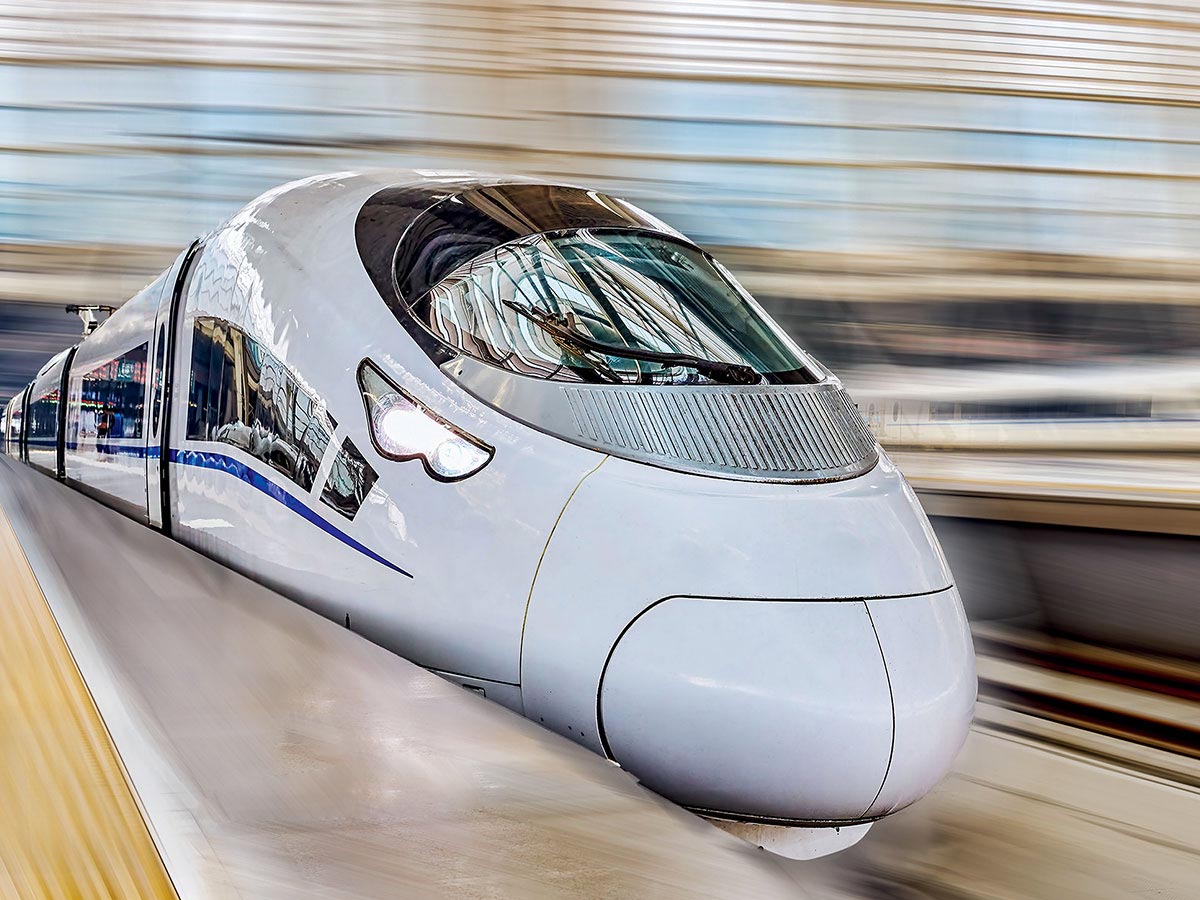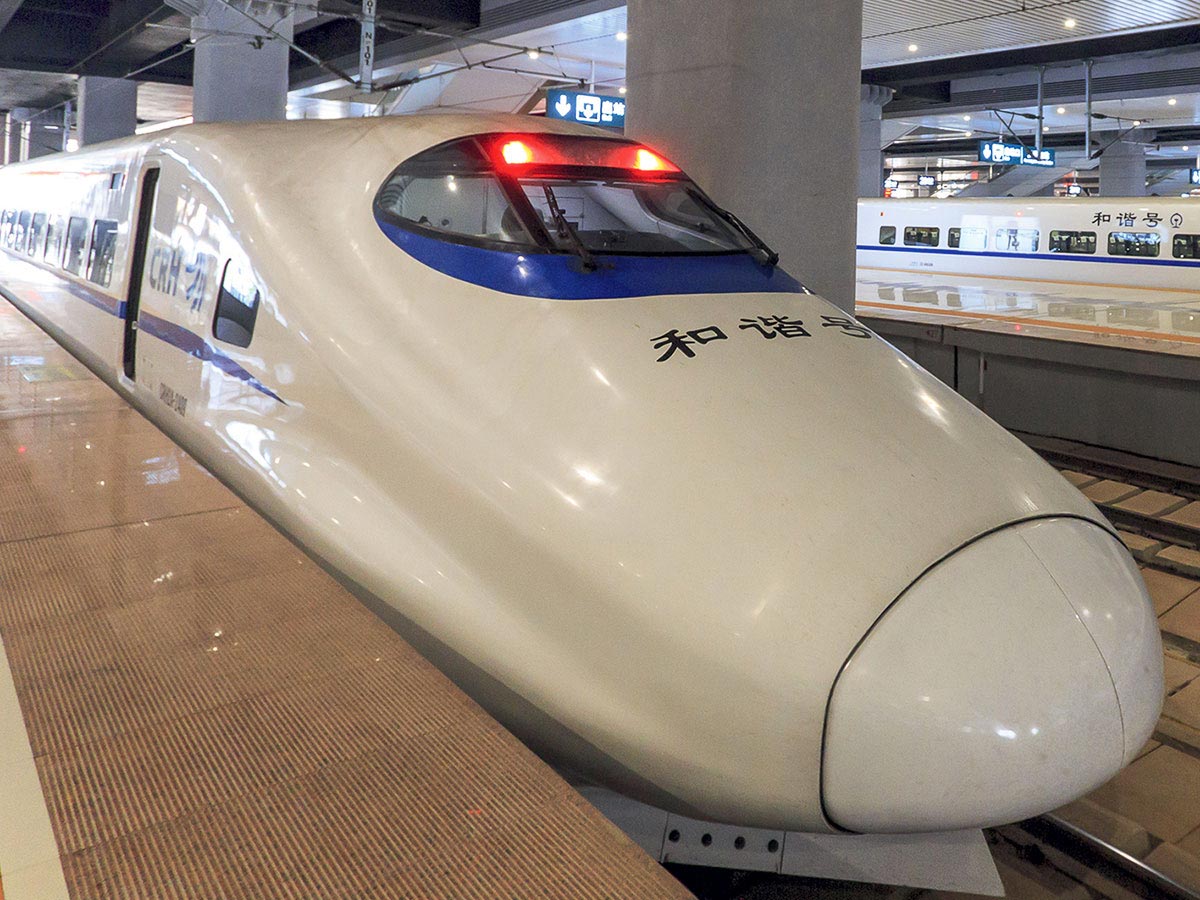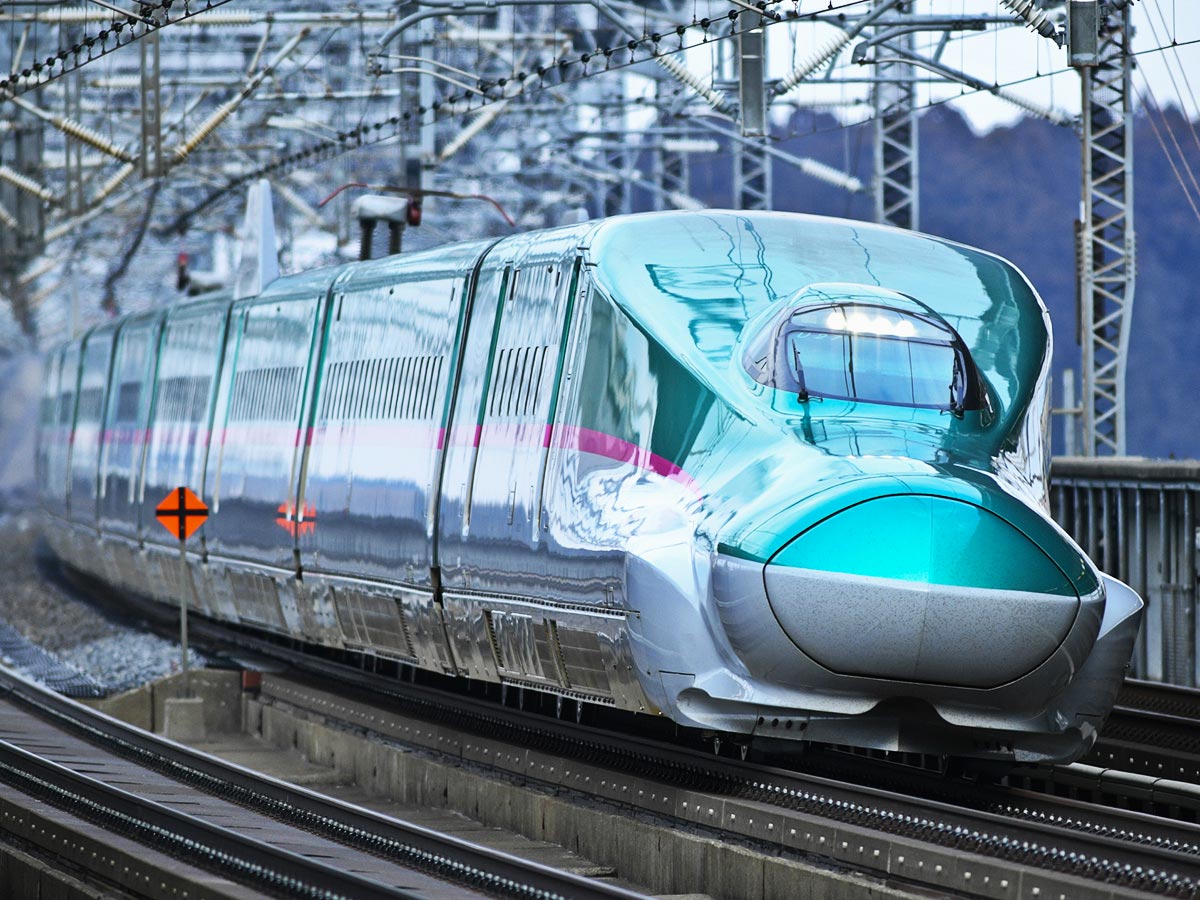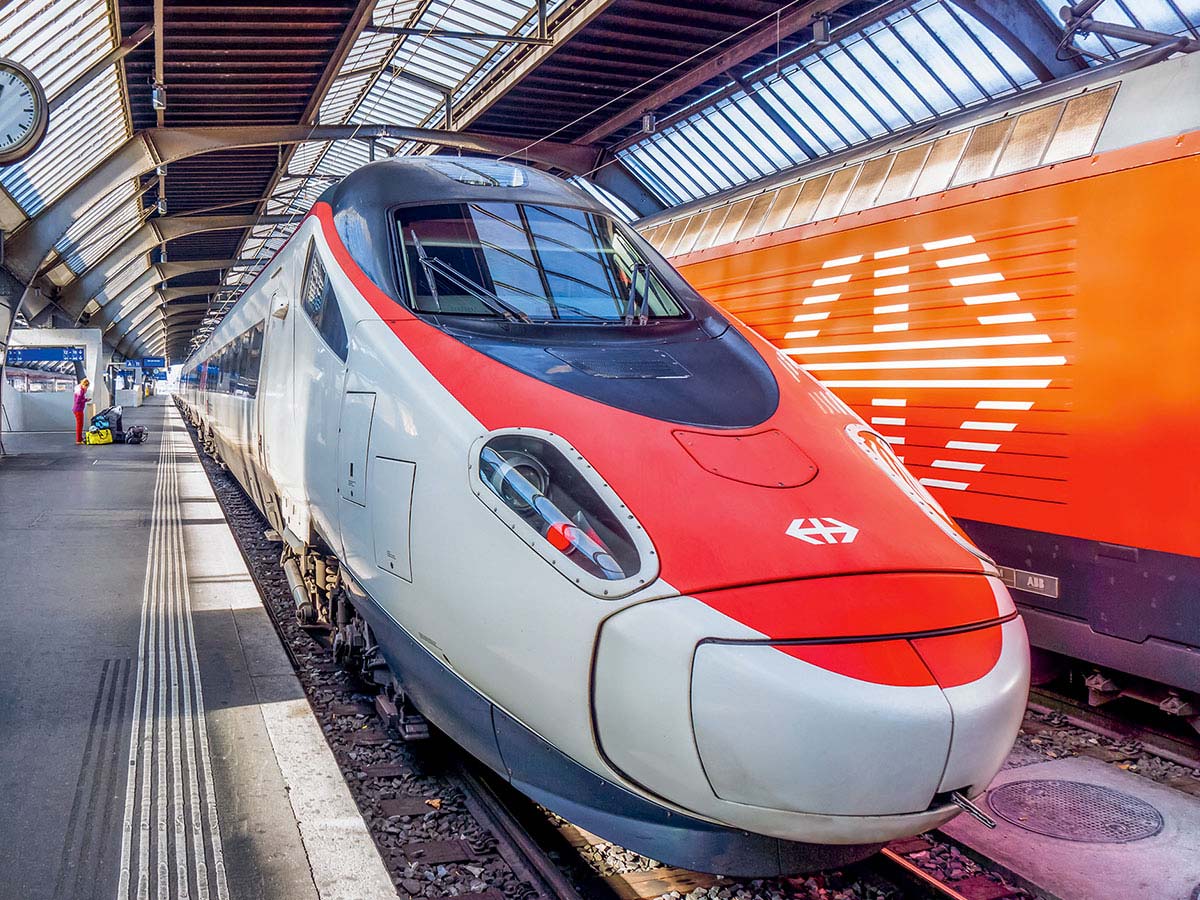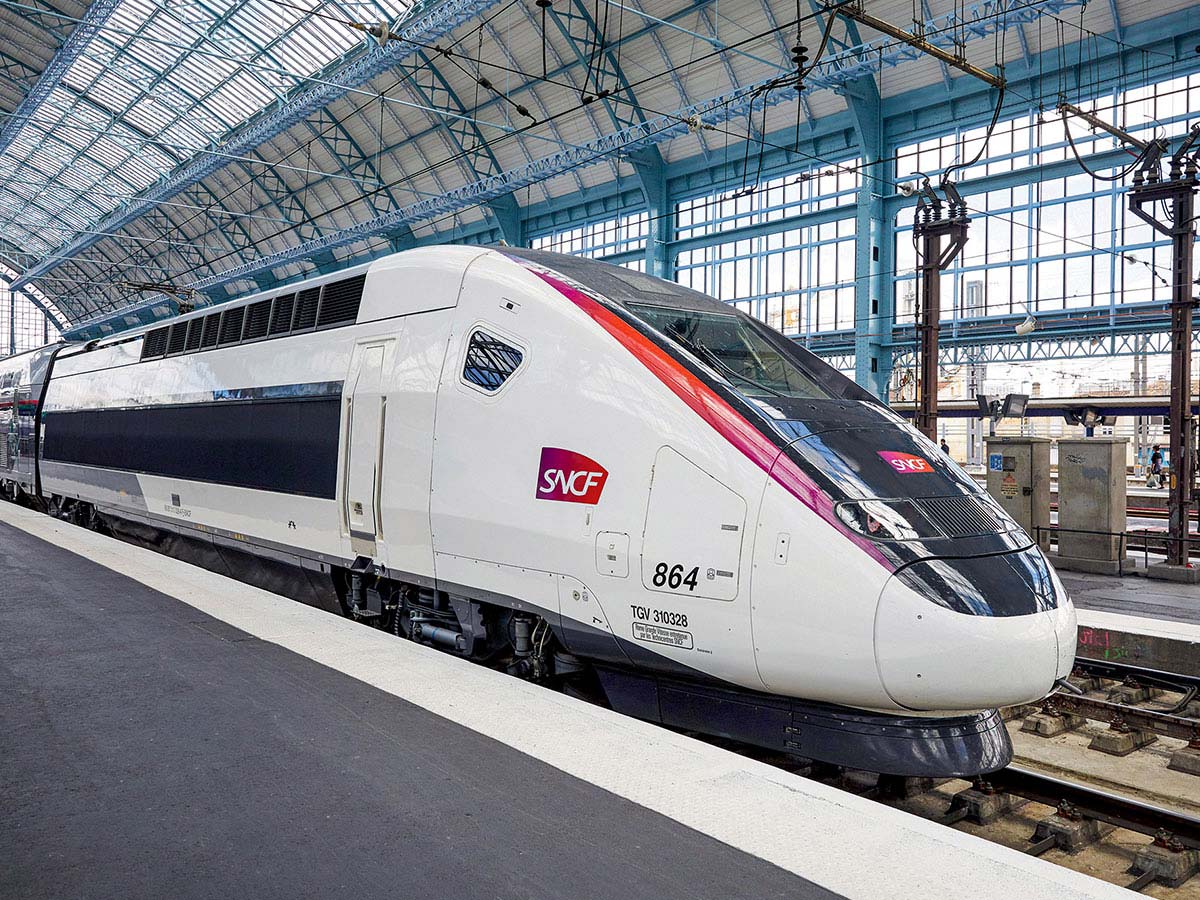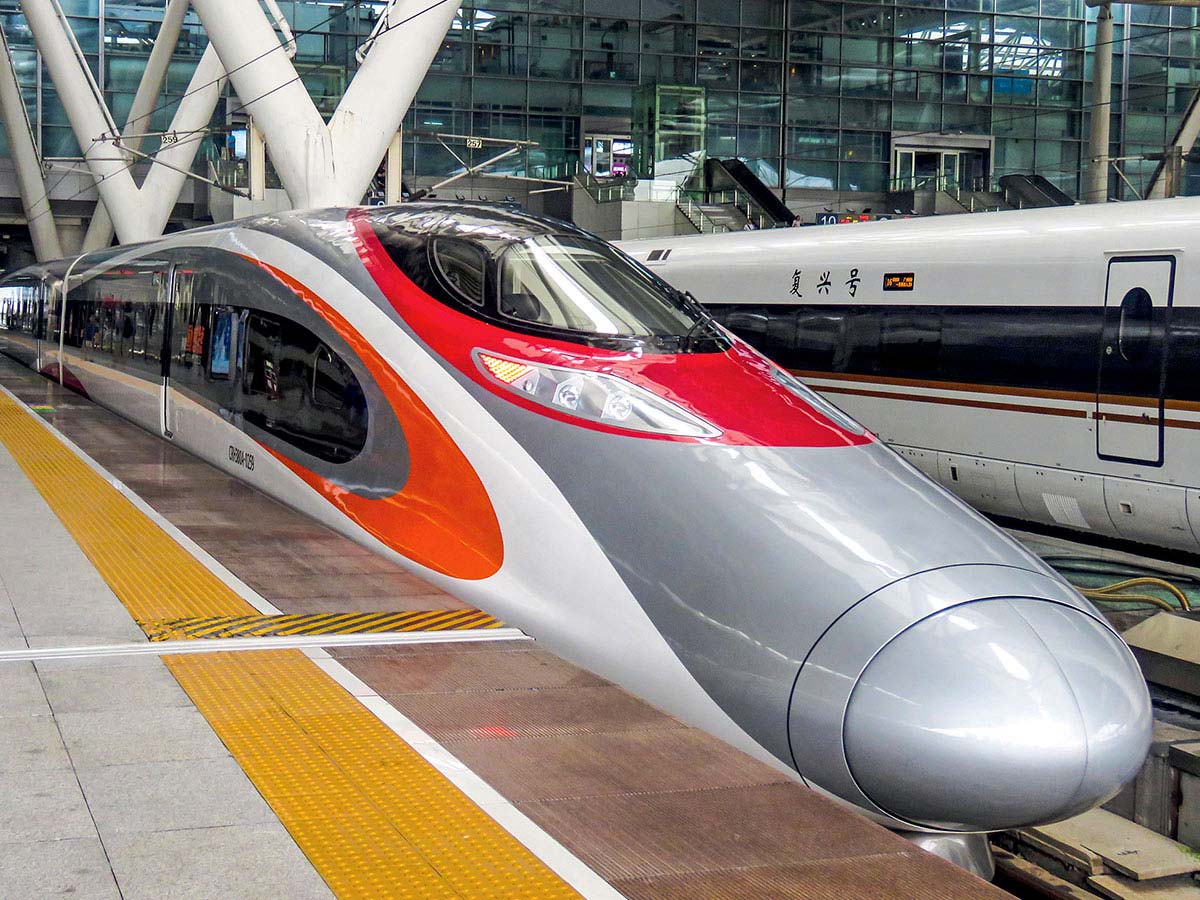COLOGNE > FRANKFURT

2002 | GERMANY
Journey

More Info
- Length in km: 180 km
- Name of the train: ICE (Intercity Express)
From the highest peaks of the Alps in the south to the Baltic Sea sand beaches in the north, Germany unfurls a landscape of majestic rivers, romantic forests, and picturesque villages. This natural beauty offers another side to the image often associated with this European giant of high economic performance. After France and Italy, Germany is the third European country to have developed an ambitious internal network of high-speed rail lines, composed of both renovated and newly-constructed tracks. Inaugurated in 2002, the Cologne-Frankfurt line is entirely dedicated to high-speed, linking the two great urban centres of commerce and industry. The international vocation of these regional capital cities is also affirmed by rail connections to Paris, Brussels, Amsterdam, and Zurich.
Leaving Cologne
In Cologne (Köln), the welcoming city on the banks of the Rhine River, the twin spires of the city’s cathedral catch the eye. Completed in 1880, six centuries after its construction began, this fl amboyant Gothic jewel is impressive in terms of generous dimensions and interior design. The climb up the 509 steps leading to the top of the tower is rewarded by a panoramic view of the city and its river. A few steps away, coloured houses coiffed with gabled roofs line the banks of the Rhine, where refurbished walking paths and gardens are the perfect spot for a stroll or to enjoy Kölsch beer, a local specialty. In the summer season, the river offers a range of excursion options. Cologne is a cultural destination, with its dozens of contemporary art galleries, museums, and many vestiges of its Roman past.
Carnival season is an institution. Every year, on 11 November at 11:11 am, a spirit of madness sweeps across the city, lasting until Ash Wednesday, five months later! Costumes and fancy dress of all kinds, spontaneous concerts, parade fl oats, fanfares, and picaresque club reunions…Carnival offers a series of memorable moments, leading to the fl ourish of its fi nal week. The main rail station of Cologne, Köln Hauptbahnhof, is one of the most active in Germany. Erected close by the cathedral, the station offers direct access to the downtown area. Nearly all high-speed trains travel across the famous Hohenzollern Bridge, a symbol of the city with its six tracks spanning the Rhine. Arrival in Cologne is always a surprise, as the train appears to head straight for the cathedral until the line turns sharply to enter the station.
Toward a high-speed line
In the 1970s, the Deutsche Bahn (DB) undertook the first studies to consider construction of a high-speed national network from Hamburg in the north to Munich in the south. The OPEC-led oil crisis of 1973 slowed the momentum of the project, which intended to run trains at 300 km/hr. In 1991, two high-speed lines, Mannheim-Stuttgart (107 kilometres) and Hanover-Wurzburg (327 kilometres), dedicated to passengers and to freight, were put into service for train sets running at a maximum speed of 250 km/hr. In 1998, Hanover was connected to Berlin by another high-speed line. Anticipated as early as the 1970s, the new Cologne-Frankfurt line responded to an urgent need to alleviate congestion on the two existing rail lines bordering the Rhine, both overwhelmed by the volume of traffic.
The project took long to materialise, arousing much debate over the route to be chosen. Each of the Länder, or German states, along the route proposed their own needs and objections. Must the train serve Koblenz, an important city on the left bank of the Rhine? Or Bonn? Should the LGV run alongside the river, thus doubling the existing conventional InterCity-line? In 1989, the government adopted a definitive route along the A3 motorway. North of Frankfurt, one branch heads west to Wiesbaden, while another extends to the south-east, toward Frankfurt airport, before reaching the city. The line, inaugurated in 2002, was named Köln-Rhein/Main. Uniquely designed for passenger transport, the line left freight transport and local passenger traffic to the two other existing 2-track lines. In 2004, a rail connection linking the Cologne-Bonn airport to the Cologne-Frankfurt line was added. Since 2011, the two cities are only fifty-four minutes apart, connected by the most direct train. This line, which connects to the network toward Dortmund and Munich, is an essential link in not only the German network, but also the European network, as it continues on to Basel, Brussels, Paris and Amsterdam.
The Rhine-Alps corridor
The Cologne-Frankfurt line takes its place within the heart of the Trans-European Transport Networks (TEN-T), a vast programme of transport infrastructure development instituted by the European Union. This link along the Rhine-Alps corridor constitutes one of most well-travelled tracks in Europe for freight transport. This line connects the North Sea - and its ports in Rotterdam and Antwerp – to the Mediterranean and Genoa, passing notably through Switzerland and Milan, Italy.
Cologne-Frankfurt, the journey
From the main station in Cologne, some of the trains reach Konrad-Adenauer Airport in a matter of minutes, travelling under the airport’s terminals. New station tracks were added at Siegburg/Bonn station, where a fast light rail connects this station with Bonn, a few kilometres to the west. The former capital city of West Germany, replaced by Berlin since the country’s reunification in 1990, is a peaceful city, with an attractive array of museums, churches, and classical music festivals in tribute to native son Beethoven. The train reaches cruising speed, leaving behind the memory of the Rhine, symbol of a romantic Germany composed of tranquil villages, hillside castles, and elegant bell towers. At the narrowest bend in the Rhine lies the legendary rock cliff of Lorelei. This place is full of mystery, associated with the mythical nymph whose exquisite song lured sailors to a watery death. The train winds through an undulating countryside studded with deep valleys, passing close by the Siebengebirge. The name translates literally as “the seven mountains”, this natural reserve is intended to protect the flora and fauna of a park of mountains covered in beech and oak forests, the vestiges of an ancient volcano. A series of tunnels follow one after the other, and among the vineyards of the Rhineland valleys, water is everywhere, in the form of rivers or ponds. The small rail station at Montabaur provides access to a regional railway line serving small towns in the Westerwald region. A bit further on, east of Limburg, the line crosses the Lahn River, and certain trains stop at Limburg Süd. There visitors can enjoy the old pedestrian town centre lined with charming half-timbered cottages and the famous Limburg Cathedral. Exactly 40 km south of Limburg, the train enters the Main River plain. At Breckenheim junction, two tracks head west to Wiesbaden, known for its hot springs, and Mainz, the birthplace of Gutenberg, the celebrated inventor of the printing press. The main tracks turn eastward, cross the river Main and lead the train first to the underground station at Frankfurt Airport, then on into the city.
Innovative solutions
The legal constraints and geological problems arising from the construction of the high-speed route were resolved in 1998, and the line was inaugurated in 2002.The selected route avoids the swath of the Rhine, shortening travel time by following the most direct route, the A3 motorway. The line passes nevertheless through small mountains presenting quite steep slopes. This is one of the reasons for which the line is reserved for ICE3 (Intercity Express 3), a new generation of train sets that are adapted to precipitous terrain. Freight trains do not have access. The line is 180 kilometres long and includes thirty tunnels – the longest of which is Schulwald at 4.5 kilometres – as well as eighteen bridges. Between Siegburg and Frankfurt Airport, new tracks were laid on concrete slab, which, though more expensive to manufacture and install, saves costs in terms of maintenance. In relationship to the mixed-use German lines, the curve radii are tighter but nevertheless allow train sets to run at speeds of 300 km/hr.
Pioneers
The first ICE trains to circulate on the high-speed network were pioneers in the field, travelling at lower speeds and less powerful than the subsequent ICE3 models. The ICE1, with its boxy nose, began to run in 1991. The train’s two locomotives framed a maximum of twelve cars. The restaurant car in the middle is easily recognisable by its higher rounded roof. Launched in 1996, the ICE2 is shorter, and its single power unit allows for the choice to shorten or double train sets.
The German railways use an automated speed control system (LZB) that signals occupied block sections in front of the running train and slow-down sections, and provokes automatic acceleration/deceleration and braking of the train. This system is gradually being replaced by the more modern ETCS, the European Train Control System. As for remote control, it is effectuated from control centre based in Frankfurt.
→ Verdant landscape near Raunheim.
ICE, a train and a line
ICE (Intercity-Express) is the brand of the high-speed trains of Deutsche Bahn (DB AG). This brand also represents the commercial line on which the trains run. ICE1, ICE2 and ICE-T train sets circulate only on lines equipped with the voltage system corresponding to energy supply of Germany, Switzerland and Austria. The third generation of ICE, the ICE3, was built in a 4-voltage system variant for cross-border traffic within the Trans-European High-Speed Network. Only ICE3 trains travel along the Cologne-Frankfurt line. These train sets were specially developed to affront the precipitous terrain of the route. The shape is derived from earlier versions of ICE trains, differing notably in a more aerodynamic nose and the pale grey livery with a red band running below the windows.
This new generation, developed by the Siemens-Bombardier industrial group, is not designed with a locomotive, but as electrical multiple units (EMUs). Four of eight elements of these EMUs are driven; the rest are trailers. The train is capable of reaching a maximum speed of at least 320 km/hr. Drivers’ cabins are separated from passenger seating by a simple glass panel. The ICE1 trainsets were designed by well-known industrial designer Alexander Neumeister, while the grey-blue seats and deep grey carpeting were developed by the Peters Institute in Stuttgart. These train sets include a bar car with a dining area, and rolling cart service offer drinks for sale. Staff members wear the navy-blue uniform of the German railway. First-generation trains will be gradually replaced by the ICE4, recently acquired by the DB. These trains are very comfortable, with family spaces, children’s compartments and more ergonomic seating. Digital tickets have become the norm. Reservations are not required, and on-board control is systematic, due to the fact that ICE train platforms are shared with other lines, and thus all rail passengers have access.
→ Deutsche Bahn ICE 3, currently the fastest train in Germany.
Arriving at Frankfurt
A striking image of the economic success of Frankfurt, a major centre of European finance, is the multitude of high rise towers that serve as a high-tech backdrop to charming older districts, reminiscent of German villages. There are atmospheres, neighbourhoods, and habits to suit all tastes. The historic centre is clustered around Romerberg Square, with its half-timbered houses and elegant Gothic cathedral. In the university district of Bockenheimer Street, students gather in the lively bars to drink Apfelwein, a tart apple cider. South of the Main River, which cuts through the city, lies the Sachsenhausen quarter, home to pedestrian streets overflowing with restaurants and hip night spots. An active cultural city, Frankfurt hosts the world’s largest book fair, and is the birthplace of Goethe. Walking paths flank the banks of the Main, where most of the city’s museums are to be found. The central rail station of Frankfurt on the Main – the city’s proper name – is the terminal station of ICE trains as well as many regional trains. Nearly a thousand trains pass along its platforms every day. This modern station, with its majestic Neo-Gothic architecture, provides connections to many European destinations.
The high-speed effect
Fast links between two centres as populated and industrialised as Cologne and Frankfurt make an impact not only on the national network but also internationally. Cologne is but a few hours from Belgium and the Netherlands, and Frankfurt takes advantage of high-speed to reach Munich, Nuremberg, Stuttgart, Hamburg and Berlin, as well as Paris and Leipzig. The ICE3 run on the Cologne-Frankfurt line, as the network is not yet open to foreign operators for technical reasons. Indeed, due to its steep terrain, only certain trains possess sufficient power and braking capacity for this line.
Aside from the short travel times, the line offers other advantages to travellers: Cologne and Frankfurt airports are served by underground stations directly below their terminals, providing access from the city centres in a matter of minutes. In addition, two new stations have been built along the line. Halfway is Montabaur, a small but strongly developing town thanks to its ICE stops, and only 21 km to the south is Limburg Süd, which provides access to locals who commute to Frankfurt.
a selection of HIGH-SPEED LINES by creation date
1964

TOKYO > OSAKA
1992

TURIN > NAPLES
1992

MADRID > SEVILLE
2002

COLOGNE > FRANKFURT
2008

BARCELONA > MADRID
2010

SEOUL > BUSAN
2011

BEIJING > SHANGHAI
2014

ANKARA > ISTANBUL
2014

LANZHOU > URUMQI
2016

SHANGHAI > KUNMING
2016

TOKYO > HAKODATE
2016


ZURICH > MILAN
2018

BEIJING > HONG KONG
2018

TANGIER > CASABLANCA
